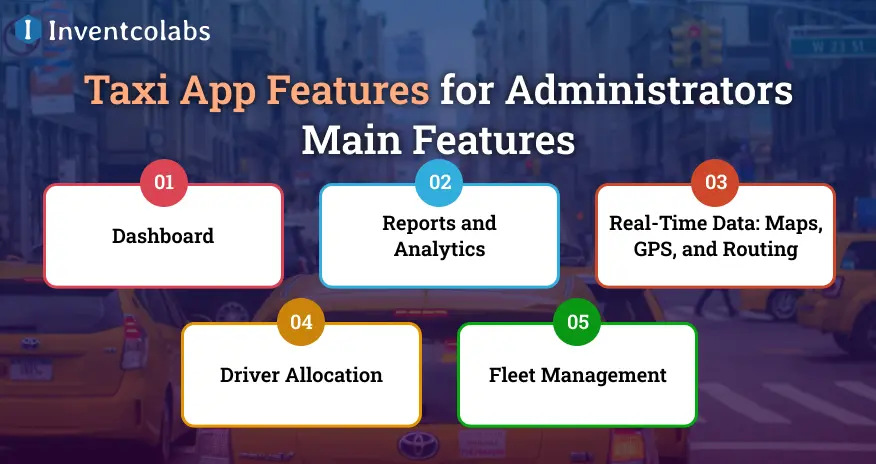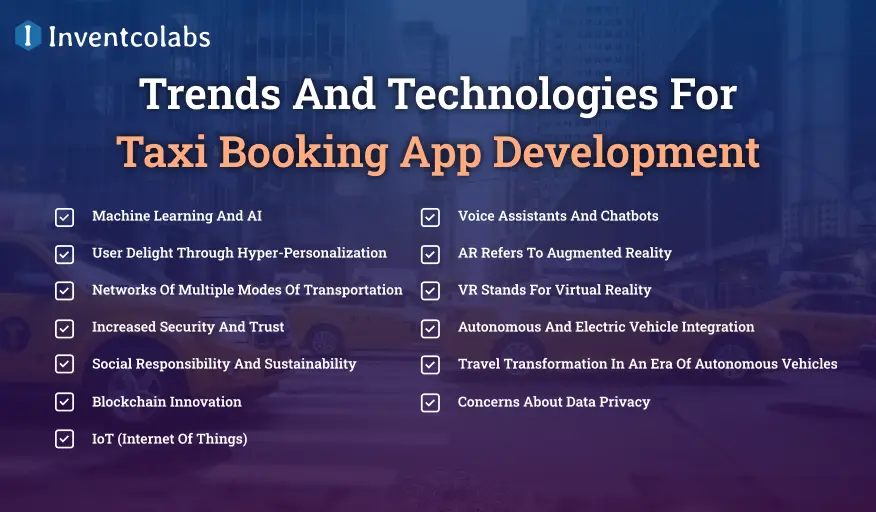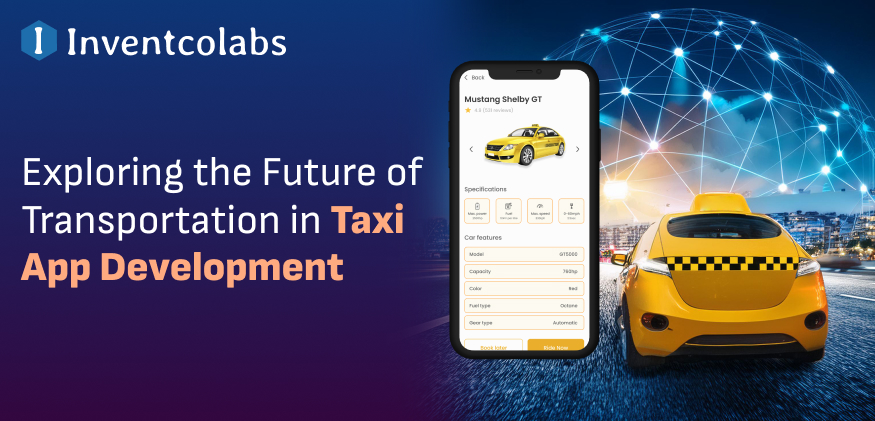As we continue to move into the digital age, traditional methods of calling cabs are being replaced with more user-friendly techniques that make hailing a cab quicker, easier, plus more productive.
Taxi booking apps have emerged as valuable tools to improve and streamline the transportation service. Because of the widespread use of smartphones and the need for services on demand, taxi booking app development or startups are now essential to succeed.
Uber and Lyft’s innovative business models have revolutionized the world of transportation. They have not only changed the way we travel but also opened up a myriad of opportunities for financial investment. Though the taxi app development cost varies depending on the clients’ requirements.
This blog post examines the latest technology and trends in the development of taxi booking apps and their impact on urban mobility.
Reasons to Create a Taxi Booking App in 2024
A taxi app developed as a component of shared mobility software could be a viable project for the taxi business in 2024. However, there are advantages and disadvantages to think about. Here are a few principal reasons you should consider doing this.
>Market growth:
- Taxi app sales are predicted to grow to $283 billion in 2028, a constant increase of 4.2 percent. This is a promising and stable market that is ready to be entered.
- The increasing use of smartphones, particularly in emerging economies, means more potential users for your application.
- Apps allow for easy booking, real-time tracking, and cashless transactions, which cater to customers’ needs for simple and convenient services.
Explore More: Guide On Taxi App Development Everything You Should Know In 2024
>Competitive landscape:
- The market is constantly evolving, which opens up space for novel features and services that fill unmet needs and distinguish themselves from established players.
- You can meet the requirements of local markets by offering affordable prices, language assistance, and agreements with local taxi firms.
- Integrating new technologies such as AI, AR, and autonomous vehicles can help create unique value propositions and ensure the future of your application.
>Additional revenue streams:
- Implementing delivery services, such as entertainment booking, food delivery, or other services on demand inside the app, could generate additional revenues.
- Premium memberships with benefits like discount fares, priority reservations, or special features may bring in additional income.
- Business partnerships with partners provide the opportunity to create corporate accounts and travel booking options for shuttle services for employees.
Taxi App Features for Administrators: Main Features

Finally, let’s take a look at the administration features.
>Dashboard
The dashboard on taxi booking apps for administrators is an essential command center. It provides an exhaustive overview of platform activities and allows administrators to make educated decisions to maximize performance and grow.
The essential elements of the dashboard include live data visualization and analysis of performance, managing user finances, financial management, marketing tools and campaigns, operations control, communications channels, and much more.
They provide the following advantages: data-driven decision-making and optimized performance, Financial transparency and control, user engagement and retention, proactive problem-solving, and an improved platform reputation.
>Reports and Analytics
The analytics and reports function as administrators’ “eyes and ears,” offering comprehensive information about the platform’s performance, user behavior, and possible areas of improvement.
Reports and analytics features provide complete data aggregation, customizable reports, visual representations of data, drill-down features, predictive analytics, analytical comparatives, and actionable insight.
Administrators will gain from this function through more excellent decision-making capability, better user experience, improved efficiency in operations, targeted marketing and promotions, financial control and forecasting, as well as managing risk, proactive problem-solving, and competitive advantage.
>Real-Time Data: Maps, GPS, and Routing
Live data in real-time that covers the maps and GPS and gives managers of taxi booking applications that crucial perspective. It’s similar to a live cockpit, providing vital information to track the platform’s operations, improve driver allocation, and guarantee an enjoyable experience for passengers and drivers.
The set of features includes live maps, which include the location of passengers and drivers along with weather and traffic updates, Dynamic route optimization, Geofencing and heatmaps, notifications and alert systems, and historical data analysis.
This functionality can help improve operational efficiency, enhance passenger experience, improve driver support, more informed decisions, proactive problem-solving, and data-driven advertising and promotions.
Read More: How To Build Taxi Booking App Like Uber In 2024: A Detailed Guide
>Driver Allocation
The allocation of drivers within a taxi booking app is similar to an attentive secretary, ensuring that the driver in the right place finds the appropriate passenger at the proper time. This feature is important for managers, maximizing the platform’s efficiency, earning for drivers, and, ultimately, passenger satisfaction.
The primary functions of driver allocation include real-time matching algorithms, Geofencing, zone management and geofencing, skill and preference matching, fairness and transparency, dynamic change, rerouting and adjustments, feedback, and performance monitoring.
The platform’s efficiency has improved, resulting in higher earnings for drivers. Improved user experience, decreased operating costs, improved retention and engagement of drivers, and proactive problem-solving are just a few of the system’s advantages.
>Fleet Management
The fleet management feature in the taxi booking application is the orchestrator in charge of the fleet of vehicles, making sure your application operates efficiently and smoothly. It’s a feature with multiple functions that allow administrators to maximize the performance of their cars, streamline maintenance, and ultimately maximize the value of their fleet.
The principal features of fleet management are real-time tracking of vehicles, monitoring of vehicle condition and diagnostics, as well as preventative maintenance scheduling. Energy efficiency analyses and optimization tracking of driver behavior, coaching, monitoring compliance and reporting, as well as communication and scheduling tools.
The benefits for administrators include lower operational and downtime, increased safety for drivers and performance, improved platform performance and reliability, and data-driven decision-making. It also improves coordination, communication, and greater transparency and responsibility.
Trends And Technologies For Taxi Booking App Development

Trends and Technologies are currently developing to help facilitate taxi reservation apps.
Before discussing the latest technology and developments in taxi booking apps, it is crucial to comprehend exactly what the application involves.
Taxi booking apps are an online platform that allows customers to book taxis and cabs on their mobile phones, linking customers with drivers in the vicinity for a real-time booking experience, which may include estimation of fees as well as live tracking capabilities and payment integration apps, applications that accept payments, payment options such as cashless payment and payment gateways, as well as payment options.
Technological advancements have impacted industries and businesses of all types, from taxi app development company to logistics firms and consumer-oriented businesses.
Today, it is simpler than ever before for businesses to provide low-cost services while also providing outstanding customer service, offering low-cost options, and enhancing user experience and user-friendly interfaces, especially in the taxi industry, such as taxi booking apps. Let’s look at the most important developments.
>Machine Learning And AI
Machine learning and artificial intelligence technologies have profoundly impacted the creation of taxi booking app solutions.
Applications can use these techniques to predict user behavior, resulting in better user experiences and more personalized user interfaces. Tools for forecasting peak hours use these technologies, too, since they study passengers’ travel habits and recommend routes for drivers to take, which results in greater efficiency.
Machine learning algorithms could examine customers’ travel history to predict when and at what time their next trip is likely to be. This would help businesses create a more personalized experience for customers by offering related services or customized discounts, which would ultimately increase customers’ happiness and revenue growth.
>User Delight Through Hyper-Personalization
Customization is fast becoming the core of taxi application development today. There is no longer a need for generic services. Personalization suggestions, recommendations, and alternative routes are fast becoming standard and help improve the user experience and increase loyalty.
Explore More: Develop a Taxi Booking App in 2024: Success Guide
>Networks Of Multiple Modes Of Transportation
Ride-hailing services go beyond the automobile; their holistic strategy for transportation covers a range of modes of transportation, such as scooters, bikes, and public transportation, to offer commuters end-to-end solutions that allow seamless mobility between different modes within one application.
>Increased Security And Trust
Safety has always been the top concern in ride-hailing; however, the safety aspect will be a priority in the near future. To protect riders with rigorous background checks, monitoring in real-time and emergency services, advanced features, crucial options, and other features are now part of these services, making trust the key to long-term performance.
>Social Responsibility And Sustainability
These are the fundamentals of the development process and require attention. The ride-hailing app industry has embraced its function as a change agent and is an essential participant in the urban transportation environment.
Their sustainable projects, community partnerships, and urban planning collaborations are proof of their commitment to enhancing the quality of life in cities and communities.
>Blockchain Innovation
Blockchain innovation will be an exciting trend in taxi booking apps. It offers secure transactions that increase trust among users and increase transparency by logging every transaction and fact in an immutable digital ledger.
Imagine a person contesting an amount. Blockchain is a reliable account of every transaction. It improves consumer trust while safeguarding information and reducing fraud.
>IoT (Internet Of Things)
The Internet of Things has revolutionized every aspect of business, including demand for taxi booking applications. Using IoT in taxi apps helps improve safety standards by tracking cars’ locations and monitoring drivers’ behavior. It also provides information that can enhance routes or decrease the time it takes to get a taxi.
IoT devices installed in taxis provide real-time information on the vehicle’s location, speed, and driver behavior. This can help organizations monitor drivers’ performance while also ensuring the safety of passengers.
>Voice Assistants And Chatbots
As natural machine learning and artificial intelligence improve, Chatbots and voice assistants are becoming more popular in online taxi booking applications.
AI-powered apps could help users book rides swiftly, respond to common queries about their journey, and offer immediate updates.
For instance, a person could tell the voice assistant, “Book me a ride to Central Park at 5 PM,” and the application would take care of everything, making the process swift and simple.
>AR Refers To Augmented Reality
AR is in its early stages but already shows potential as a groundbreaking taxi booking software platform. AR lets drivers navigate using 3D navigation features while also delivering customers to their taxi cab booking application, which is available in real-time, significantly improving the customer experience and interactions.
For example, AR navigation systems for drivers could overlay directions and routes on real-world photos of roads to make navigation more accessible and easy.
AR technology could also inform customers where their taxi booking mobile app is being developed in real time, further improving the user experience and the customer experience.
>VR Stands For Virtual Reality
Virtual reality technology can transform certain services on demand, such as virtual try-ons of furniture and clothing purchases, remote assistance, and interactive entertainment.
>Autonomous And Electric Vehicle Integration
With the growing crisis for environmental sustainability, many taxi firms are introducing electric vehicles.
Additionally, the self-driving technology of cars could drastically alter how taxi services are currently provided by incorporating this technology into applications is something to look for.
While still a long way from being a common practice, Companies have already begun testing self-driving vehicles as ride-sharing services. As this technology becomes more common, it could significantly impact taxi booking apps.
>Travel Transformation In An Era Of Autonomous Vehicles
Self-driving vehicles were previously only featured in science-fiction films; nowadays, they’re ordinary transport industry films.
Self-driving vehicles could revolutionize the ride-hailing industry by offering high-quality safety and ease of use; however, hurdles must be overcome before autonomous taxis can drive themselves.
>Concerns About Data Privacy
With trust from users becoming more important to app developers’ achievement, secure measures must be taken to build the confidence of app users as well as increase the level of satisfaction with app users.
How to Create an Efficient Taxi App?

Taxis are growing in popularity because they are a quicker and more efficient means of transport, particularly in cities with traffic. In addition, with the rising popularity of ride-sharing applications, developing a taxi application could be a lucrative business idea.
Where do we begin?
Developing a taxi application can be a financially profitable business idea, particularly in areas with a huge need for transport services. Let’s look at the steps in creating an app for taxi services.
>Research
Before launching any business, research is essential. Conduct market research to discover your region’s need for taxi services. Analyze your competition, the market you want to target, and pricing plans. Discover what works for your competition and their customer complaints about them, and then try to improve your app to give customers an improved customer experience. This will give you a leg up over your competitors and allow you to succeed in this business of transportation that is booming with colors. This is logical. What features do we need to add to the application?
>Define your App Features
From the user’s perspective, a feature is an essential software element. A particular element of your application, such as its assistance files or an aspect of a complete product, can be removed or added based on the user’s preferences. Your app for biking should have the following functions:
- User App
The app for the user is an app for customers that lets them book a ride, keep track of the driver’s location, and rate the driver. It should be simple to use and have an easy interface that allows users to book rides quickly.
- Driver App
The driver’s app should permit drivers to take and complete rides. It should also provide drivers with vital information, such as the pickup location, the customer’s name and contact information, and the drop-off address.
- Payment Gateway
Your app should have secured payment gateways that can support different payment options, including credit or debit cards, net banking, and digital wallets.
- GPS Tracking
Your app must include GPS tracking that allows drivers to pinpoint the location of your customers quickly and swiftly navigate to their location.
- Rating and Review System
The rating and reviews system is crucial to hold the driver and the customer accountable to each other. It lets customers review their experience with the driver and provide feedback about the driver’s behavior.
>Choose the Right Platform
After listing all options and features, it is time to pick the best platform to publish the taxi app. You can launch your app from the Google Play or Apple app stores. Additionally, you could select both platforms to launch your app and expand your business to a larger size by targeting users on Android or iOS.
>Hire a Professional Team
If you’re looking to begin your business within the Taxi industry, employing experts on your team is one of your top priorities. Employ a team with experience building mobile applications, explicitly ride-sharing apps. The team should consist of an account manager, UX/UI designers, front and back-end developers, and quality assurance (QA) testers, and they should help you turn your vision into a reality with no difficulties.
>Develop the App
The development of travel apps involves creating the user interface and user experience, creating the front-end and back-end, and integrating APIs to support various options, such as payment gateways and GPS tracking.
- UI/UX Design
The UI/UX design is vital because it determines the ease of use of the application. Employ a seasoned UX/UI designer to design an app that is simple to use, visually pleasing, and easy to use.
- Front-end Development
Front-end developers are responsible for creating the app’s interface. They employ programming languages like Java, Swift, and React Native to build the app’s style and function.
- Back-end Development
Back-end developers are responsible for constructing the app’s logic and features. They utilize programming languages like Python and Ruby to develop the app’s server side.
Explore More: Uber-like Taxi Booking App Development Company: App Ideas to Consider in 2024
- API Integration
API integration is vital to allowing payment gateways, GPS trackers, or other services provided by third parties. The Taxi booking app development company should integrate APIs with care to ensure smooth operation.
>Test and Launch
After the development process is completed, the app needs to be tested thoroughly to confirm that it is working as planned. The QA team should be able to test the application to identify glitches, bugs, and compatibility issues on a variety of gadgets and OSs. Following testing, the app should be made available in app stores. Be sure that your app meets the requirements set out in the stores’ apps. Launch a marketing campaign to help spread the word about your app and draw customers’ attention.
>Maintain and Update
The taxi app needs periodic maintenance and updates to ensure smooth operation. Engage a team of experts to provide ongoing maintenance and support to the application. The app is updated constantly to add new features, correct bugs, and enhance user experience.
Conclusion
The radical transformation of the taxi app has transformed everything about transportation, resulting in the highest quality of service and convenience available to customers globally. Taxi Mobile App Development Companies are at the heart of this revolution, pioneers in designing contextually accurate solutions that meet the needs of changing markets. Taxi App Development Services can use its knowledge to develop Customized Booking Solutions for Taxi applications that improve the user interface for customers and drivers.
The significance of taxi applications in a world that is driven by speed and convenience can’t be understated. Taxi app developers are constantly seeking ways to improve the viability and accessibility of their services as the world becomes more mobile-oriented and technologically focused. From real-time tracking and precise fare calculations to sophisticated security features, Taxi App Development Companies are committed to creating novel mobile applications focused on pleasing their users while ensuring they are safe.





